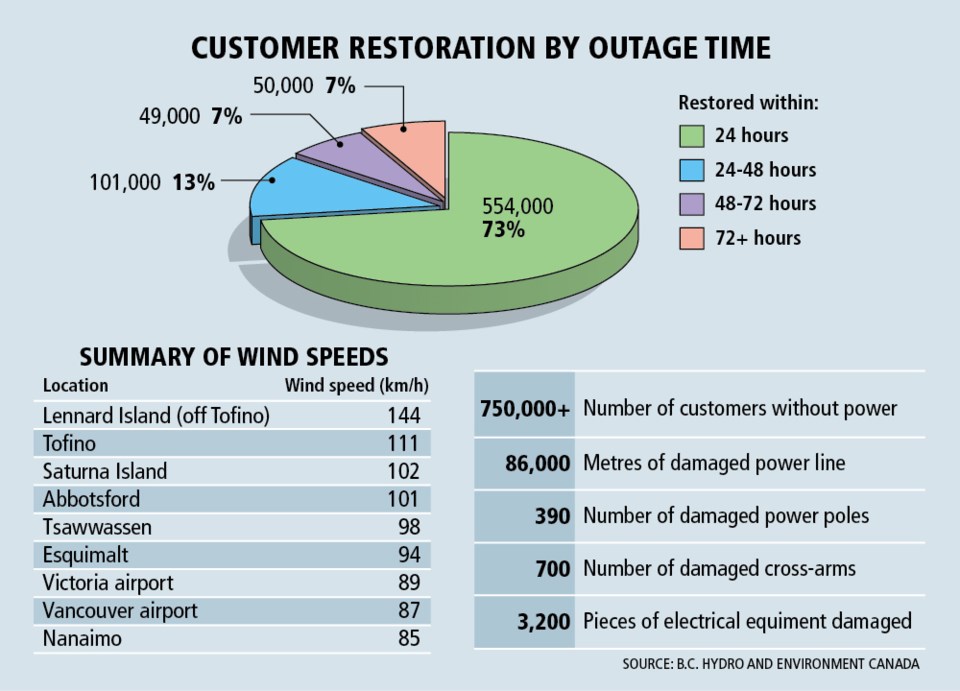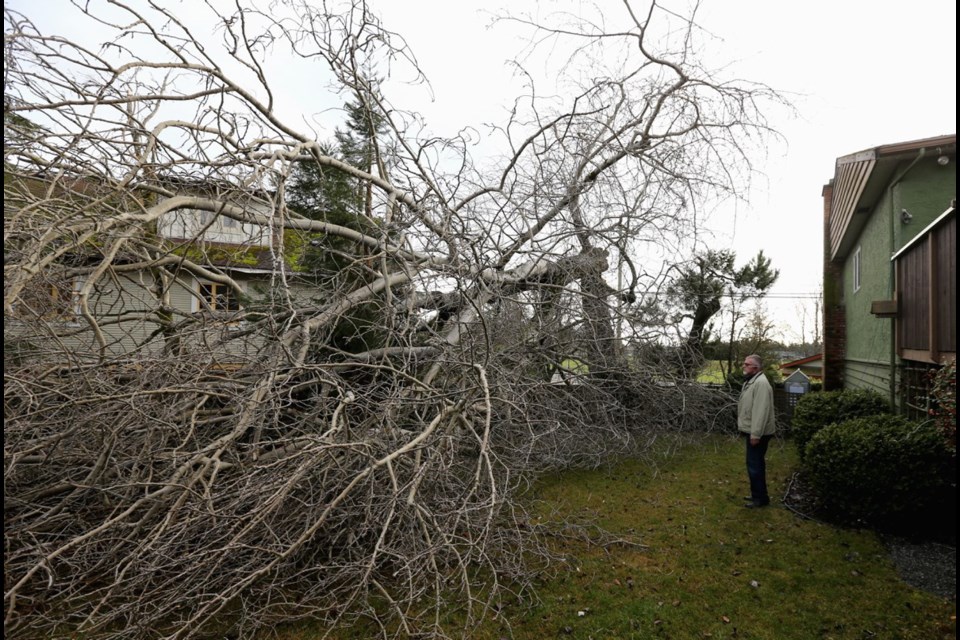A late December storm that wreaked havoc on Vancouver Island and the Gulf Islands, tearing up trees and ripping down power lines, was the most destructive storm on the south coast in B.C. Hydro’s history.
The Dec. 20 windstorm affected more customers, caused more damage and required more resources than any previous storm, according to a B.C. Hydro report entitled Storm Report released today.
“Responding to this storm involved our biggest mobilization of crews, equipment and materials ever,” said B.C. Hydro president Chris O’Riley.
The utility has yet to tally the cost.
The storm saw winds coming from multiple directions — generally in the range of 70 to 100 kilometres an hour, with gusts topping 100 kilometres in some areas.
“With winds above 100 kilometres per hour and the storm on a perfect track to do damage, the result was complete destruction in some areas,” the report says.
In the early morning, winds came from the southeast, by the late morning from the south, and by afternoon they were from the southwest. In Duncan, those southwest winds were endured for more than 12 hours. On Salt Spring and some of the other southern Gulf Islands, the southwest winds howled for eight hours.
The winds were preceded by more than 400 millimetres of rain in some areas. “Saturation reduces the stability of the soil and some coniferous trees, like Douglas firs and hemlocks, have shallow roots, making them more vulnerable,” the report says.
All this combined to destabilize and uproot many trees, sending trunks and branches to the ground and taking power lines with them. There were power outages throughout Vancouver Island, the Gulf Islands and parts of the Lower Mainland and Fraser Valley.
The Ministry of Transportation’s Drive B.C. website showed trees down on 100 per cent of the roads on some of the southern Gulf Islands.

More than 750,000 customers were without power from Parksville to Victoria on Vancouver Island, the Gulf Islands, and West Vancouver to Mission on the mainland.
The storm left about 80 per cent of all customers on Vancouver Island and the Gulf Islands — nearly 350,000 customers in all — without power at some point, according to the report.
B.C. Hydro said the Dec. 20 storm was more damaging than an August 2015 windstorm that hit the Lower Mainland and Fraser Valley and a 2006 windstorm that hit Vancouver Island and ravaged Stanley Park.
Thousands of pieces of electrical equipment were damaged or destroyed. Portions of the distribution system needed to be completely rebuilt.
The utility had more than 900 field personnel working to repair damage to more than 1,900 spans of wire, 390 power poles, 700 cross-arms and 230 transformers, O’Riley said.
Immediate dangers such as live wires across roads or near homes and restoring power to hospitals, for instance, were priorities for utility and roads crews.
Before the storm, B.C. Hydro said its in-house and contracted meteorologists were tracking the incoming system and utility crews were ready to respond.
They were soon overwhelmed.
The report says more than 5,800 trouble orders — work assigned to Hydro crews to restore power which may include removing a tree or replacing a power pole — were made. That is 19 times greater than the number of trouble orders the utility handles during an average storm.
In the Gulf Islands, some crews had to travel by water taxi while heavy equipment was sent over by barge.
“Moving this many crews and bringing the trucks, heavy machinery and materials that were needed to rebuild the system over to the many islands and regions added an additional layer of complexity,” the report says.
Given the storm slammed four separate regions, B.C. Hydro crews could not be everywhere at once.
“B.C. Hydro crews also had to complete a lot of repair work in rural or remote areas, which required extensive work off the main roads without the support of trucks,” the report says. “Crews we required to get to some sites by ATV or hike through forests on foot.”
B.C. Hydro restored power to more than 550,000 customers in the first 24 hours on Vancouver Island. Gulf Islands customers waited up to 11 days to see power restored.
All customers saw power restored by midday Dec. 31.
B.C. Hydro and road crews and other emergency responders were praised for their work over the holidays to restore power, re-open roads and repair damage.
However, the utility concedes there were problems and lessons learned.
Some customers couldn’t report downed lines because 911 operators in some areas were overwhelmed with calls, said the report. Others couldn’t find their outage status.
“Reflecting on how we can improve is an important part of how we debrief after every storm,” O’Riley said. “We will continue to work on improving how we respond to storms so we will be ready for the next event Mother Nature throws at us.”
B.C. Hydro said it will continue to focus on improving its storm preparation and response using its smart meter network and new technology in prediction logic for outages, new mobile dispatch tools and improved meteorology tools.



